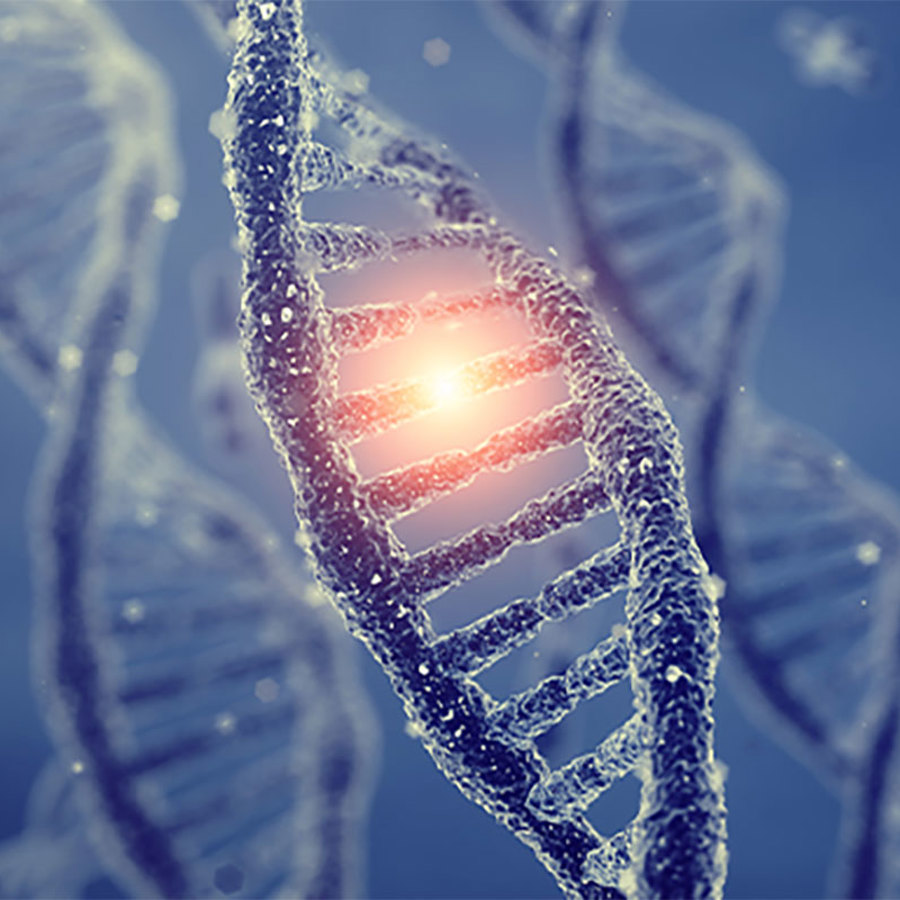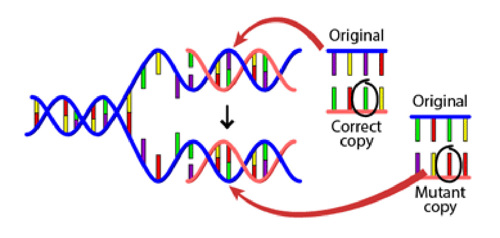
What is a mutated gene?
August 14, 2008

- Related Topics:
- Mutation,
- Genes to proteins
An elementary school student from California asks:
“What is a mutated gene?”
Words like mutated make people think of giant spiders attacking San Francisco. Or of Storm sending a lightning bolt to beat Magneto.
Real mutations are much less exotic than this. A mutation is simply a change in DNA. So a mutated gene is a change in the DNA of a gene. Nothing more, nothing less.
These changes can have big effects. Or they can have little or even no effect. The changes can be helpful, harmful or neutral.
To really understand what a mutated gene is, we first need to go over what a gene is. Then we can understand what mutating it means.
A Gene Has the Instructions for Making a Protein
Genes are really just the instructions for making a protein. Each protein does a different job in the cell.
For example, hemoglobin is a protein that helps our blood carry oxygen. And amylase is a protein in our spit that helps break down the food that we eat.
Think about it like the instructions for building a Lego model. Some instructions let you build a car. Others let you make a rocket, a house, etc.
Of course, genes aren’t written in English (or any other human language). They are written in something called the genetic code. The genetic code sounds tricky but it is much simpler than human languages. Genes are written in DNA. And DNA is made up of just four letters – A, G, C, and T.
The “words” these letters form are also much simpler. English has hundreds of thousands of words that are anywhere from 1-29 letters long (although there are technical words that are even longer). The genetic code has just 64 words that are all three letters long.
So a mutation in a gene changes letters in these words. This might or might not affect the instructions for making the gene's protein.
Some Mutations Affect Proteins More than Others
Because of how the genetic code works, changes in a DNA letter may or may not affect how a protein works. In other words, some DNA changes have an effect while others don’t.
Think about a protein like a Lego racecar, with its gene being the instructions to build it. Different changes to the instructions have different effects on the racecar.

A ‘silent’ mutation is a change in the DNA that doesn't change the protein's ability to do its job. In this case, there is no change in the instructions.
For example, changing a blue block to a red one in the middle of the Lego racecar wouldn’t change its function as a racecar. In fact, we wouldn’t even be able to notice the change by looking at the car.
A ‘missense’ mutation, on the other hand, causes a change in a protein by affecting one word in its instructions. Sometimes it can change the protein's ability to do its job. These changes can have large or small effects.
For example, a small effect could be changing a blue block to a red one on the outside of the racecar. This would change its look, but it would still work just fine.
A large change would be removing a wheel and putting a door in its place – that wouldn't make for a fast racecar! Some of these sorts of large changes in genes can cause diseases like sickle-cell anemia.
A ‘nonsense’ mutation causes part of the gene’s instructions to go missing. This definitely affects a protein’s ability to do its job! Half a protein is about as useful as half a race car!
Changes like these can definitely cause diseases. For example many different nonsense mutations that all affect the same specific protein, the cystic fibrosis transmembrane conductance regulator (CFTR), all result in cystic fibrosis. Other diseases caused by nonsense mutations include haemophilia, retinitis pigmentosa and duchenne muscular dystrophy.
A ‘frame-shift’ changes the instructions so that everything that comes after is read differently. This can result in extra short or extra long proteins. These proteins are usually unable to do their jobs normally, but sometimes can have completely new functions.
For example, if halfway through the instructions for the racecar we started having unreadable instructions, our racecar wouldn’t be too useful. But if we started having instructions for a spaceship halfway through the racecar instructions, we could end up with something totally new and cool!
Frame-shift mutations in specific proteins can also be responsible for different diseases. For example, different frame-shift mutations in the Beta-hexosaminidase A protein can result in Tay-Sachs disease, a disease of the nervous system.
Many Things Cause Mutations
Mutations are actually very common. Sometimes chemicals or UV light from the sun can cause a mutation. And sometimes our cells do it to themselves!
When a cell makes a new copy of itself, it needs to copy all 6 billion letters of DNA too. Our cells are pretty good at fixing any mistakes but they aren't perfect. The occasional change makes it through.

Remember mutations are not all bad. Some of us can drink milk as an adult because of a mutation. In fact, all the wonderful variety around us comes from old mutations. For example, all the different eye colors that humans have are a result of old mutations that have lasted so long that they have become common in the population*.
Without mutations, we might all look the same! So even though their effects are not as dramatic as in the movies, life would be a lot more boring without mutations.
*An old mutation that becomes set in a population is called a variant.

Author: Sandeep Ravindran
When this answer was published in 2008, Sandeep was a Ph.D. candidate in the Department of Microbiology & Immunology, studying protein secretion mechanisms of the parasite toxoplasma in John Boothroyd’s laboratory. Sandeep wrote this answer while participating in the Stanford at The Tech program.
 Skip Navigation
Skip Navigation
